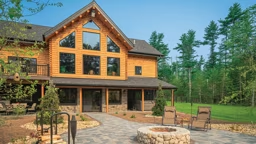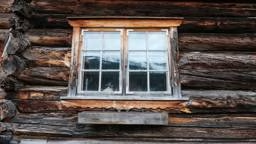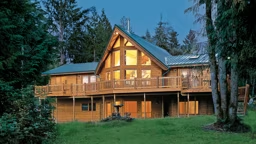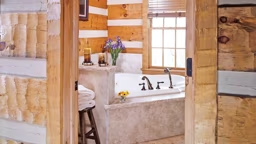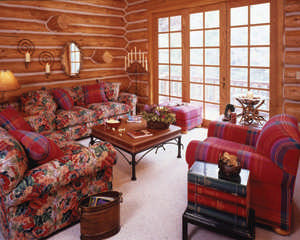
Photo: Maple Island Handcrafted Log Homes
No matter how hardy and efficient your glass is, because there’s such a high percentage of it in the sunroom, the biggest heat loss will be through windows. So you want to invest in glass with energy-efficient coatings that can both insulate the room and block out the sun. Energy efficiency is measured with the U-value and the R-value. The U-value is a measure of the heat gain or loss through glass due to the difference between the indoor and outdoor temperatures. The lower the U-value, the less heat is transmitted through the glass.
The R-value measures the overall resistance to heat flow. The higher the R-Value, the less heat is transmitted through the glass. While insulation is a key concern, blocking the sun is even more of an issue. “The thing that most people think about with sunrooms is insulating against the cold in the winter,” says James Ruppel, marketing director at Four Seasons Solar Products in Holbrook, New York. “But in a room of glass, you’re bigger concern is the solar heat gain co-efficient (SHGC). Think about what it’s like in a car with a lot of glass. Even on a sunny winter day, the car can be warm.”
The SHGC is the fraction of solar energy admitted through a window, both directly transmitted, and absorbed and subsequently released inward. It has. The lower SGHC, the less solar energy it transmits, and the greater its shading ability. Here’s a basic look at coated glass performance, complements of Windsor Windows. Justin Sparks, Director of Building Design at Everest Custom Builders in Donnelly, Idaho, explains key terminology.

Window Lingo:
Visible light:
This is the portion of the electromagnetic spectrum that produces light that can be seen. The visible transmittance (VT) is an optical property that indicates the amount of visible light that is transmitted through the whole window. The higher the VT, the more light is transmitted, so select windows with a higher VT if the goal is to maximize daylight and the view.
Winter U-factor:
An older window with a lower glass temperature feels colder because more heat is radiated from a person's body to the window. Cold glass can also create uncomfortable drafts as air next to the window is cooled and drops to the floor. This sets up an air movement pattern that feels drafty and accelerates heat loss. High-performance windows with lower U-factors will result in warmer interior windows in the winter and thus greater comfort. (For cold-weather climates, a U-factor of .35 or less is required by the new 2008 energy code.)
Fading transmission:
Many organic materials, such as carpet, fabrics, paper, artwork, paints, and wood can fade upon exposure to sunlight. The most harmful radiation in sunlight are ultraviolet (UV) rays, which are the most energetic and thus most likely to break chemical bonds, leading to fading and degradation. Glass transmits UV rays at 300 to 380 nanometers, though this can be reduced by up to 75 percent with proper coatings. However, it is important to note that the remaining visible light (wavelengths between 380 to 720 nanometers) that’s transmitted can still fade some materials. Using Low-E glass or windows incorporating plastic layers rather than clear uncoated glass helps.
Solar blockage:
This is the fraction of solar radiation admitted through glass either transmitted directly and/or absorbed, and subsequently released as heat inside a home. The lower the SHGC of the glass, the less solar heat it transmits and the greater its shading ability. A product with a high SHGC rating is more effective at collecting solar heat gain during the winter. A product with a low SHGC rating is more effective at reducing cooling loads during the summer by blocking heat gained from the sun. Therefore, what SHGC you need should be determined by such factors as your climate, orientation and external shading.







